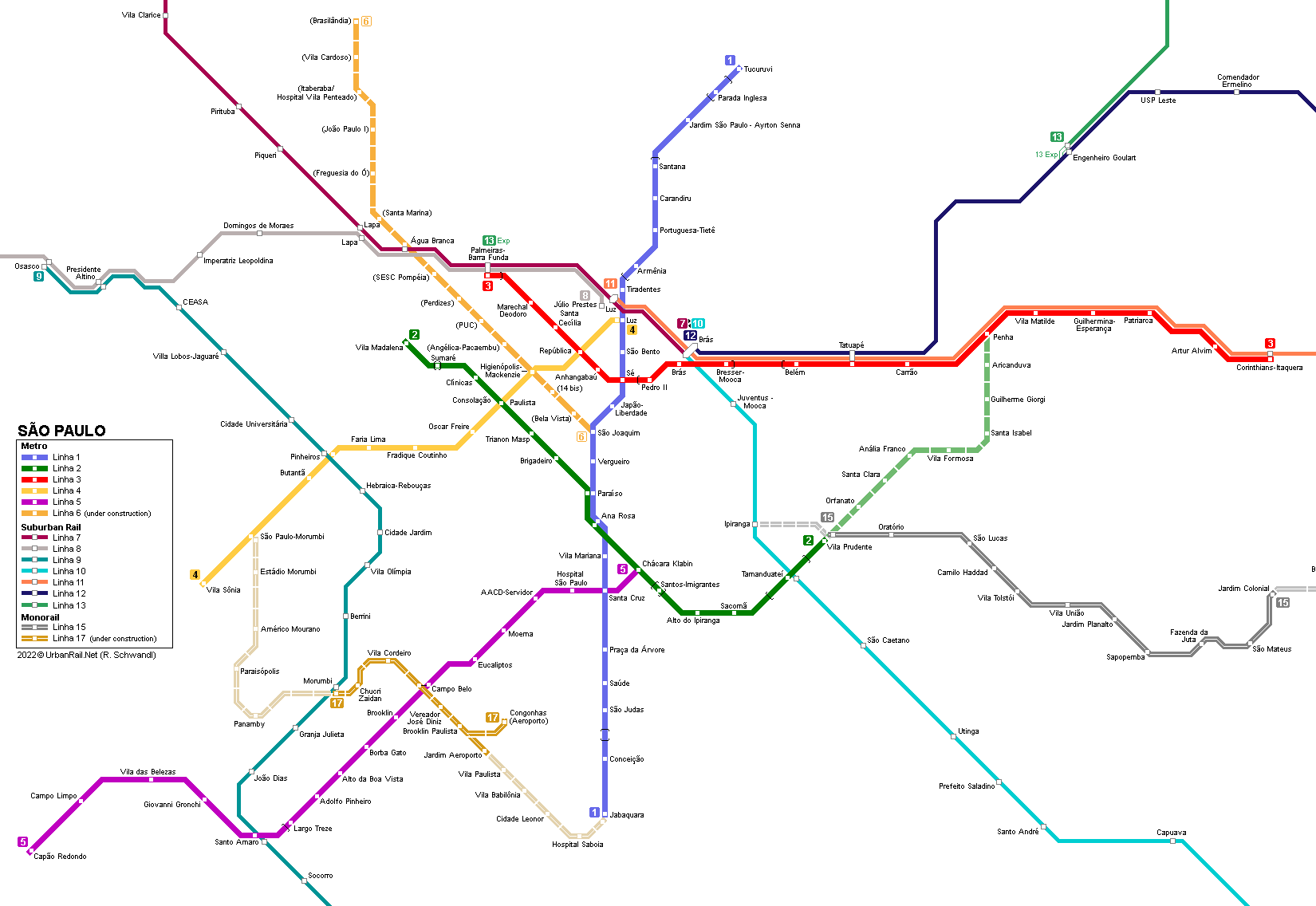
|
[ UrbanRail.Net ] [ Europe ] [ Americas ] [ Asia ] [ Africa ] [ Oceania ] [ News ] [ Books ] [ Links ] |
|
SÃO
PAULO
|
| São Paulo . Brazil |
Click to expand to full size map including all suburban railways
|
METRO
|
||
|
São Paulo's is among the younger metros in the world and it's considered one of the most modern although today's extension does not cover all areas of this populous city. The proper metro network (Lines 1-5, 83 km) is complemented by a monorail line (line 15) and a 260 km suburban network operated by CPTM and ViaMobilidade (Lines 7-12).
|
||
|
Lines
& History
|
||
| ... | ||
| Metro Lines | ||
| Linha 1 Azul | Line 1 Blue | ||
|
(20
km - 23 stations - Jabaquara - Tiradentes underground, Jardim São
Paulo and Tucuruví also underground) - 1600
mm gauge; 3rd rail power supply; operated by Metrô SP.
14 Dec 1968 - Construction work began on Line 1 14
Sept 1974: Jabaquara - Vila Mariana |
||
|
|
||
| ... | ||
| Linha 2 Verde | Line 2 Green | ||
|
(14.7 km, 14 stations, all underground) - 1600 mm gauge; 3rd rail power supply; operated by Metrô SP. 25
Jan 1991: Paraíso - Consolação |
||
|
|
||
| ... | ||
| Linha 3 Vermelha | Line 3 Red | ||
|
(22 km - 18 stations - underground between Sé and Marechal Deodoro) - 1600 mm gauge; 3rd rail power supply; operated by Metrô SP. 10
Mar 1979: Sé - Brás |
||
|
|
||
| ... | ||
| Linha 4 Amarela | Line 4 Yellow | ||
|
(12.8 km, 11 stations) - 1435 mm gauge; overhead power supply, operated by ViaQuatro 25 May 2010:
Paulista - Faria Lima (3.6 km; without intermediate stations)
- limited service 14 six-car trains were supplied by Hyundai Rotem, and the line was equipped by Siemens for driverless automatic operation (Trainguard MT CBTC); stations have platform screen doors. |
||
|
|
||
| ... | ||
| Linha 5 Lilás | Line 5 Purple | ||
|
(19.9
km - 17 stations; 8 km elevated or at grade) - 1435 mm gauge; overhead
power supply, operated by ViaMobilidade
20
Oct 2002: Capão Redondo - Largo Treze 02
March 2018: Brooklin
- Eucaliptos
(without Campo Belo; 2.9 km) 05
April 2018: Eucaliptos
- Moema (1 km) 08 Apr 2019: Campo Belo station Trains were partly built by Alstom, Siemens and CAF.
|
||
|
|
||
| ... | ||
| Linha 15 Prata | Line 15 Silver | ||
|
Instead
of an initially planned eastern extension for line 2, a monorail line
(monotrilho) is under construction from Vila Prudente to Hospital Tiradentes
(24 km, 17 stations). The line is operated driverless with Bombardier's
INNOVIA Monorail 300 system, with 54 seven-car trains (378 cars) equipped
with CITYFLO 650 automatic train control technology; operated by Metrô
SP.
30
Aug 2014: Vila
Prudente - Oratorio
(2.1 km; limited trial service)
06 April
2018: Oratório - Vila União |
||
|
|
||
| ... | ||
|
|
||
| Suburban Lines - Trem Metropolitano | ||
|
An underground system was proposed as early as the 1920s, but it was only carried out in 1968. Commuter trains, however, have existed for a long time. The oldest CPTM trains operating today are Budds from the 1950's. Today's lines A and D are the oldest ones, they are actually a single railway built in 1868 by a British consortium called The São Paulo Railway, linking the port of Santos to Jundiaí, in the coffee-producing interior. In 1901 the imposing Luz station was built in downtown SP. The small stations of line A are a little older and very beautiful. On line D they are newer and uglier (1950's-1970's). Lines B and C were part of the former Sorocabana railway, built in the 1870's to link Sorocaba to SP by a Hungarian immigrant called Maylayski. What's now line B is the main stretch, beginning at the magnificent Júlio Prestes (1936) station, just two blocks away from Luz. Line C was built in the 1950's to meet another Sorocabana stretch that went down to Santos. In the late 70's, the State government decided to create a suburban commuter line, completed by 1983. The stations between Pinheiros and Santo Amaro (formerly Largo 13) were only built in 2000/01, however, already in the CPTM age. This is strange since this is exactly the most important part of the city crossed by the line. Today it's a major financial center with tens of futuristic skyscrapers and shopping malls. Lines E and F were the important Central do Brasil railway which links Brazil's three largest cities: SP, Rio and Belo Horizonte. The main stretch is line E. Line F departs from the main road after Tatuapé and meets it again at Calmon Viana. By the 1960's and 1970's these lines, which were operated by the Federal Government (unlike lines B and C, which were State owned) began offering a suburban rail service. In the 80's and early 90's it was very lousy (lines A and D, Federal too, were just as bad) with trains running late, without many doors and windows, with people on top of them and hanging out the doors-holes. It was only in 1999/2000 that improvements began to show. The State government imported the CAF and Siemens trains for lines E, C and D and built new stations, with Metrô standard, on lines C and E. The old trains were almost all revamped. Lines B and F remain a bit lousy, however. CPTM tracks are still used by freight trains. All long distance passenger train service in Brazil, which also used CPTM's lines, was dismantled from 1997 to 2000, since privatization rules only allows the new companies to explore payload transport. (Maurício Carvalho) In 2008, the line letters were replaced by numbers to create a consistent numbering system with the Metro: A > 7; B > 8; C > 9; D > 10; E > 11; F >12 On 4 May 2021, lines 7 & 10 started through operation (Serviço 710) without the need to transfer at Brás, with a train every 6 minutes between Francisco Morato and Mauá during peak times. In Jan. 2022, operation and maintenance of Line 8 (Diamante) and Line 9 (Esmeralda) was handed over to private-sector concessionaire ViaMobilidade.
|
||
| Linha 7 Rubí | ||
|
Line 7 serves the northwestern sector of the metropolitan area but extends far beyond its limits, with a total length of 63 km. Since May 2021, it has been operated jointly with Line 10 (100.7 km).
|
||
| Linha 8 Diamante | ||
|
42 km suburban line serving the western parts of the metropolitan area, with most trains terminating at Itapevi. In the city centre it starts from a separate terminus Júlio Prestes located near the Luz hub. It then runs parallel to line 7 through Barra Funa to Lapa, and parallel to line 9 between Presidente Altino and Orasco before heading west.
|
||
|
|
||
| Linha 9 Esmeralda | ||
|
Fully converted to metro standard in April 2001; previously referred to as line C. The 3-car-trains built by CAF (Spain) run on 1600 mm tracks (formerly metre gauge) with catenary at 3000 V. Since December 2001 the definitive 10 Siemens 4-car trains have been running there, although still blended with CAFs and the 1979 Cobrasma-Francorails. 17 Oct 2007:
Jurubatuba - Autódromo |
||
|
|
||
| Linha 10 Turquesa | ||
|
Line 10 serves the southeastern sector of the metropolitan area, with a total length of 37.7 km. Since May 2021, it has been operated jointly with Line 7 (100.7 km).
|
||
|
|
||
| Linha 11 Coral - Expresso Leste | ||
|
(24+26.8 km) 27 May 2000 - former Line E operating from Brás to Guaianases, with three new stations in eastern S.P.: Dom Bosco, José Bonifácio and Guaianases. 8 stations along the former suburban line were closed to create an express metro line running parallel to line 3 (red). From 10 Nov 2003, trains have been running through to Luz. The outer section between Guaianases and Estudantes is operated separately and thus a change of trains is required at Guaianases. |
||
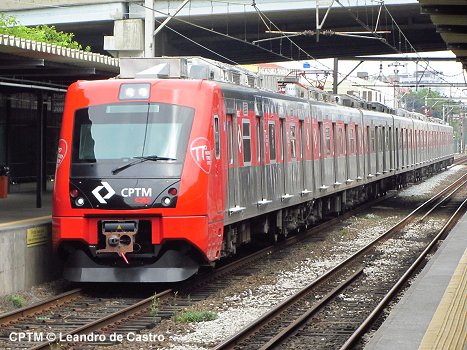
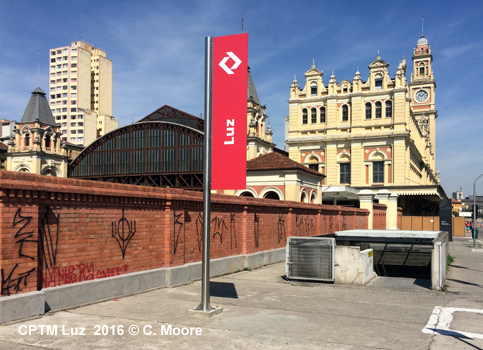
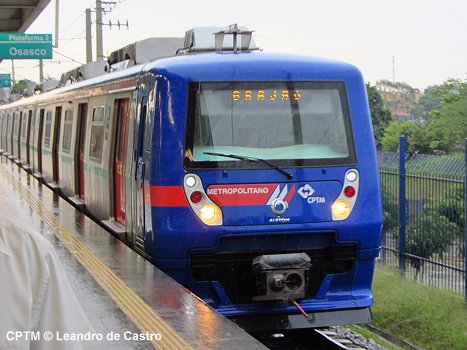
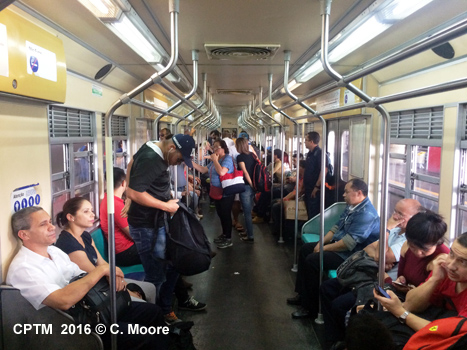
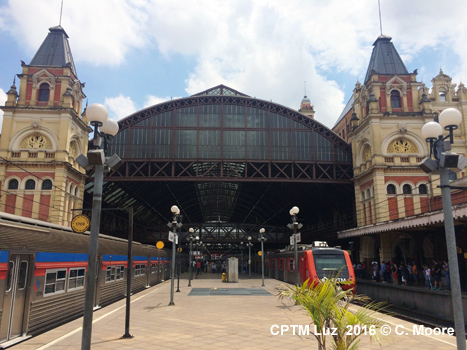

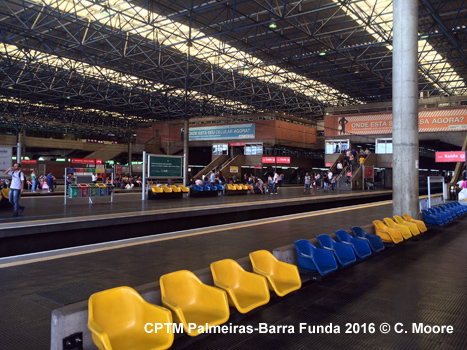

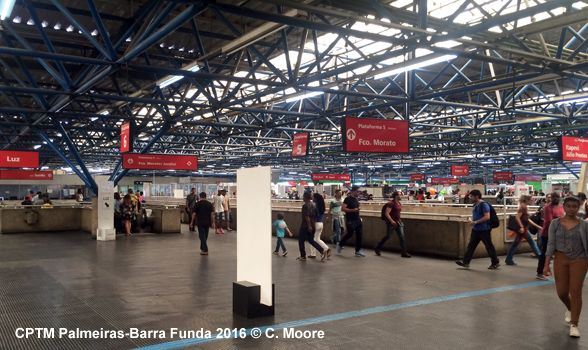
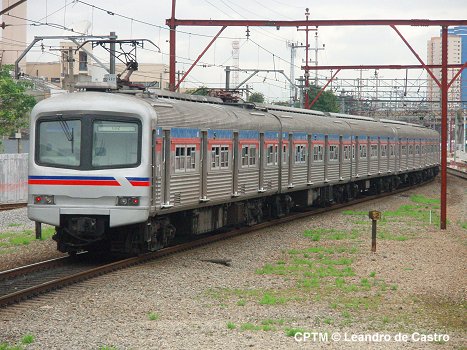

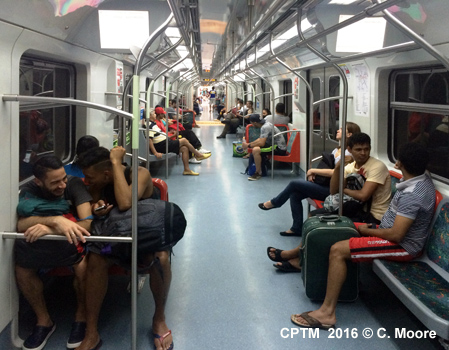
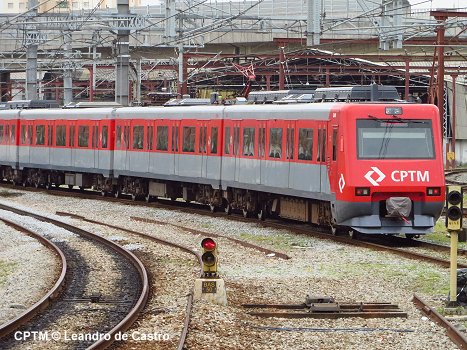
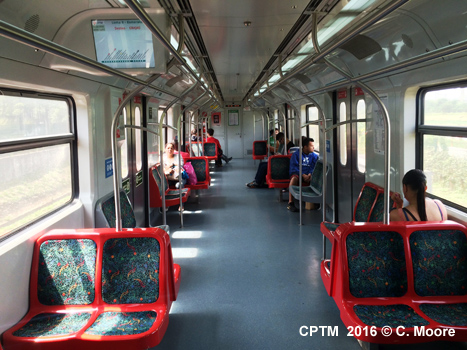
|
||
| Linha 12 Safira | ||
|
39 km suburban line serving the eastern parts of the metropolitan area. It then runs parallel to line 11 from Brás to Tatuapé.
|
||
| Linha 13 Jade | ||
|
CPTM branch serving the city's major airport; with some express trains running through to Luz on line 12 tracks. 31 March
2018:
Engenheiro Goulart - Aeroporto Guarulhos
(12.2
km) - limited
service
|
||
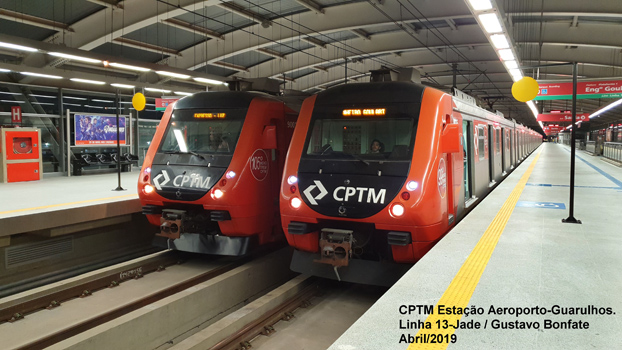
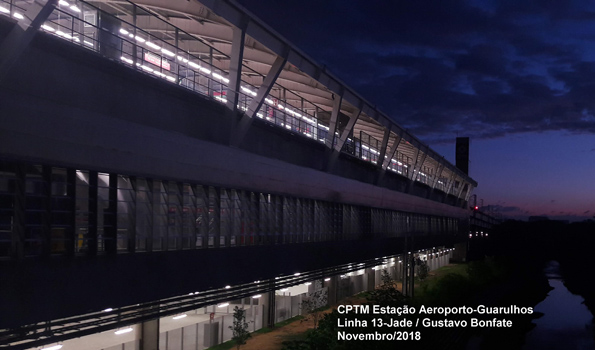
|
||
|
Projects |
||
|
Line 6 - Orange - will run for 15.9 km between Brasilândia and San Joaquin, with 15 stations. The standard-gauge line will be equipped with CBTC, allowing for automatic train operation. Construction starting in 2014 for opening in 2020. Line 11 is being extended west to Barra Funda to relieve the busy Line 3 (Integração Centro). Line 17 is another monorail which has been under construction since March 2012, with the first section linking Congonhas Airport to Murumbi station on line 9.
View diagram with all extensions for 2017; and geographical maps as of 2018, 2019 and 2020 designed by Leonardo Lisboa. Project descriptions can also be found at Skyscrapercity |
||
|
Links
|
||
|
Metro
São Paulo (official site with map)
Sao Paulo State Secretariat for Metropolitan Transports (incl. information on projects, both metrô and commuter trains) ViaQuatro (L4 Operator) ViaMobilidade (L5, L8 & L9 Operator) Scanned map from my collection (1995) 68K ANTP - Associação Nacional de Transportes Públicos Metro São Paulo at Wikipedia and Wikipedia.pt CPTM Lines at Wikipedia.pt
|
||
|
|
||
|
In Oct. 2016, Craig Moore reports from São Paulo: São Paulo is the largest city proper in the Southern Hemisphere and has an interesting and expansive urban rail system comprising of a five-line Metrô system, a six-line suburban rail network and a short Monorail. These 12 numbered/colour-coded lines have both physical and functional integration and represent 340km of services, making the São Paulo rail system the largest in Latin America. The São Paulo Metrô system consists of five full Metrô lines and a short Monorail. It has 79.3km (48.6km underground) of full Metrô and 2.1km of Monorail service, with a total of 68 stations. Services run from 0430-0000 and base headways are 3mins, although trains run at 90-second intervals during the long peak periods. Line 1 (Azul) is 20.2km in length (16.0km underground) and has 23 stations (18 underground). The 1600-mm-gauge line is the oldest on the system and runs from the north of the city, where the line is mainly elevated, to Jabaquara in the south. It connects with three other Metrô lines and has cross-platform transfer with Line 2 at Paraíso. Line 1 also has interchange with the CPTM suburban rail hub at Luz and with two Rodoviária (bus) stations, Tiete being the largest in Latin America. Most of the stations are built in a brutalist style with concrete the main construction material. They are quite angular and dark and have many walkways to direct the passenger to the platforms which have queuing barriers at the centrally located stations. Most of the stations have side platforms and there are coloured wall panels and occasional pieces of art to brighten the otherwise 'heavy' environment. The original Budd A stock is still used on this line. Line 2 (Verde) runs diagonally across the south of the city centre from Vila Madalena to Vila Prudente via the main Avenida Paulista. It is 14.7km (13.0km underground) in length and has 14 stations (11 underground), connecting to Line 1 (cross-platform transfer at Paraíso) and Line 4 of the Metrô as well as CPTM Line 10 and the recently added Line 15 Monorail at the eastern terminus. There is an equal distribution of side and island platforms and the line has some interesting stations with art works, different lighting effect and wall panelling. This is a 1600-mm-gauge line with third-rail supply. Line 3 (Vermelha) runs from the centre and its main transport hubs to the poorer eastern areas of the city. It is 22.0km long (5.6km underground) with 18 stations (5 underground). There is a 1km tunnel between Bresser-Mooca and Belem. The 1600-mm-gauge line connects to three of the four largest CPTM stations (Palmeiras-Barra Funda, Brás and Tatuapé) as well as the joint Metrô/CPTM station at Corinthians-Itaquera. It also has interchange with Line 1 and 4 of the Metrô, the former at the huge multi-level Sé station. Running underground in the city centre, the line emerges on the western bank of the Tamanduatei River. At Brás there is a lengthy bridge transfer to the busy CPTM station but subsequently the Metrô and CPTM lines join before Bresser-Mooca to form an intense multi-line rail corridor to the terminal at Corinthians-Itaquera. This corridor and its train movements can be viewed at all stations along the line to the terminus, although Belém, Penha and Patriarca are the best. The two systems are separated by a wall and there is obviously different stock and power supply, but the level of rail activity is impressive. The views of the city centre from Bresser-Mooca and Belém also add to this striking scene. This is the busiest line on the system and, as such, stations are designed for higher capacities and functionality. Stations on the line are quite basic but have large entrance areas, the above-ground stations having wide island platforms and the stations in the centre having both island and side platforms to enable quicker exit and access. Line 4 (Amarela) is the only Metrô line not to be controlled by CMSP and it is different in many ways. The ViaQuatro-operated line serves the west of the city from the Luz transport hub at 5min headways. It is 12.8km in length and is fully underground with 7 stations, four of which connect to other lines via lengthy transfer (Metrô Lines 1, 2 and 3 and CPTM Line 9). The service is fully automated and runs on 1435-mm-gauge track with smart yellow and black Hyundai Rotem stock. This stock has side seating and the through trains are very stylish with RTI and audio notices. The journey is also very smooth and quiet. The station areas are smart with a highly visible yellow colour scheme and there are three-quarter platform screens, next-train information and passenger information in Portuguese and English. There is an immediate sense that you are in a different Metrô environment, but Line 4 plays a strategically important and full part in the overall rail network and there is barrier-free access at all transfer stations and joint ticketing and marketing with the other Metrô lines and CPMT services. Line 5 (Lilás) is isolated from the remainder of the Metrô system, connecting only with the CPTM Line 9 line at Santo Amaro. The 9.6km line runs in the south-west of the city and is mainly elevated (1.2km underground) with 7 stations (2 underground). The line acts as a feeder for the CPTM service at Santo Amaro and the Metrô station here is located above the Rio Jurubatuba and is very impressive. The Line is also different from other CMSP services as it has 5min headways, uses 1435 mm gauge, has overhead power supply and uses specific F stock. Line 15 (Prata) is a straddle-beam Monorail operating in the east of the city and is an interesting new development for the São Paulo Metrô system. Currently, only a 2.1km segment between the first two stations is open, including the impressive Vila Prudente station, which is also the terminus of Line 2. Transfer between the two services takes approx 5mins and involves several escalators and walkways. The high-level Monorail stations are smart and clean, as is the modern Bombardier Innovia stock. The automated trains take 3mins to complete the rather jerky journey and the service currently acts as a shuttle with a speedy turnaround time at both terminals, providing 8min headways. Currently the service is not well used but once extended further east, the projections for use are high. Whilst the Metrô operates within the city proper, rail provision to and within Greater São Paulo is served by suburban rail services operated by Companhia Paulista de Trens Metropolitanos CPTM (Lines 7-12). CPTM was created in 1992 following the amalgamation of different rail services in the region and is one of the busiest suburban networks in the world. It is also fully integrated with the Metrô, having barrier-free transfer at 8 stations. The 1600-mm-gauge network of 6 lines has 92 stations and runs over 258.4km using overhead power supply. Two lines have Metrô standard services: Line 9 (Esmeralda) runs in western/southern São Paulo through the modern Brooklin area and alongside the Rio Jurubatuba where it connects to Metrô Lines 4 and 5. The line is fully segregated and well patronised, with modern stations, new 8-car CAF stock and 10min base frequencies. Line 11 (Coral) runs from Luz to Estudantes and has two distinct services - the relatively slow express line runs through the urban area with 7 stops to Guaianases, operating parallel to Line 3 from Brás to Corinthians-Itaquera (see Line 3 above). At Guaianases there is transfer to the outer line to Estudantes. Line 11 has 7-10min headways, impressive station infrastructure and is served by 8-car stock. The remaining lines (Line 7-Rubi; Line 8-Diamante; Line 10-Turquesa; and Line 12-Safira) run to more peripheral areas. Headways remain short but there is more basic infrastructure, longer station distances, and regular use of older stock. In general, the CPTM lines are well branded and form a genuine part of the intense urban rail environment of São Paulo. Here, special mention should be made of the foremost stations on the system located on the 6km stretch of line crossing the northern part of the central area. Palmeiras-Barra Funda, Luz and Brás are large and busy (as is Tatuapé further east) and are the main hubs for the suburban rail network. Palmeiras-Barra Funda is served by the two eastern suburban lines (7/8) as well as being the terminus for Metrô Line 1. It is a large modern station with the most directional signs I've ever seen at a station. Luz is a beautiful 19th century structure and serves Lines 7 and 11 as well as Metrô lines 1 and 4. This is the most central of the CPTM stations and has huge passenger numbers. Finally Brás, in the eastern city centre is the most unkempt of the three main stations but is the busiest CPTM station, serving lines 10, 11 and 12 as well as having interchange with Metrô Line 3 (via a long walkway). The physical scale of these stations and the volume of rail and passenger traffic is striking. Overview São Paulo has a very impressive urban rail system. It is an intensive, large and busy system that covers this huge urban area in an efficient and organised manner. The system has different modes and styles, gauges and power supply but is a comprehensive and coherent brand with seamless integration. Stations vary in style and quality but all have a SSO office/CPTM Ticket office which provides information and have plentiful supplies of the basic schematic map (CPTM offers a different version of the map). There are no automated ticket machines (only for rechargeable cards) but Bilheterias are centrally located and often have queues. Tickets are in small paper form and are placed in the barriers, with open access on exit. A flat fare system is in operation (R$3.80/€1.08) which provides access to the entire system, making it very inexpensive to use (there is also a 24-hour ticket (24 Horas Exclusivo Trilhos) available at R$10, however this requires forms to be completed and photographs and so is of use only for regular users). On entering the system, directional signage is multilingual and very clear and there are smart information boards with large geographic and schematic route representations as well as vicinity information in both entrances and on platforms. Indeed, stations are well planned with regard to passenger flows, although the volume of passengers means movement can be slow. Transfer between lines is straightforward, although Metrô/CPTM transfer is often lengthy (as it transfer to Line 4) as stations are separately located (e.g. Brás). Metrô platforms are approx 140m long and six-car trains just fit and many platforms in central areas have funnel-shaped metal barriers for entry/exit from trains. CPTM platforms are much longer and can easily hold the 8-car sets. Because headways are so short this is definitely a 'turn up'-type system, even for the CPTM services where 10min headways are the norm. As is common in Brazil, there are no station announcements (except Line 4) and no RTI (except Line 4) or timetable information at all. There is, however, a strong security presence at stations and the Metrô/CPTM does feel like a safe environment. Also noticeable is that passengers here, and across Brazil, talk to each other and there are very few people who sit/stand engrossed in their smart phones. Social interaction is the norm and it is lovely to witness. There are several stock types in use. On the Metrô, Lines 1, 2 and 3 have similar stock and there is much interchangability. Line 1 and 2 still uses the original A and E stock although these are being phased out and most services run newer G, H, I, J (refitted A), K and L stock built by Alstom, Bombardier, Cobramsa or CAF. Line 4 uses Hyundai Rotem whilst Line 5 has Alstom F stock. In general the stock is composed of individual carriages, although there are some through sets. All trains have strip maps and system maps by the door and audio announcements in Portuguese. CPTM uses 2 x 4-car CAF, although older Mafesera stock is still used on the longer lines. The stock is generally attached to specific lines as strip maps are individual to the line (although there are trains with a full CPTM 6-line strip map. On all rail services the trains run very rapidly and approach stations at great speed before swiftly breaking.
|
||
|
Photos
|
||
|
|
||
2007 © Robert Schwandl (UrbanRail.Net)